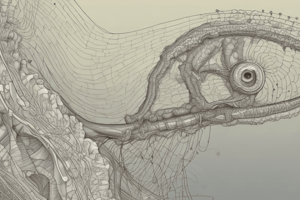Podcast
Questions and Answers
What is the primary difference between asexual and sexual reproduction?
What is the primary difference between asexual and sexual reproduction?
- The number of parents involved
- The genetic uniqueness of the offspring (correct)
- The type of cells produced
- The presence of meiosis
During which stage of sexual reproduction is the chromosome number reduced by half?
During which stage of sexual reproduction is the chromosome number reduced by half?
- Embryonic development
- Meiosis (correct)
- Gamete formation
- Fertilization
What is the main characteristic of R-Selection reproductive strategy?
What is the main characteristic of R-Selection reproductive strategy?
- Complex courtship behaviors
- Low mortality rates in the population
- Emphasis on producing many offspring with little parental investment (correct)
- High parental investment in few offspring
Which component of the male reproductive system stores sperm?
Which component of the male reproductive system stores sperm?
What is the result of the fusion of sperm and egg cells during fertilization?
What is the result of the fusion of sperm and egg cells during fertilization?
Which type of reproduction is characterized by the production of offspring that are genetically identical to the parent?
Which type of reproduction is characterized by the production of offspring that are genetically identical to the parent?
What is the primary function of the female reproductive system?
What is the primary function of the female reproductive system?
Which stage of embryonic development involves the formation of multiple layers of cells?
Which stage of embryonic development involves the formation of multiple layers of cells?
Flashcards are hidden until you start studying
Study Notes
Types of Reproduction
- Asexual Reproduction: production of offspring that are genetically identical to the parent
- Occurs in prokaryotes, some eukaryotes, and viruses
- Methods: binary fission, fragmentation, budding
- Sexual Reproduction: production of offspring that are genetically unique and combine traits from two parents
- Occurs in most eukaryotes
- Involves meiosis, fertilization, and gamete formation
Sexual Reproduction Stages
- Meiosis: process of gamete formation, resulting in four non-identical daughter cells
- Consists of meiosis I and meiosis II
- Reduces chromosome number by half
- Gamete Formation: formation of sperm and egg cells
- Sperm cells: produced by meiosis in males, motile, and haploid
- Egg cells: produced by meiosis in females, non-motile, and haploid
- Fertilization: fusion of sperm and egg cells, resulting in a zygote
- Zygote: diploid, has a unique combination of genetic traits
- Embryonic Development: development of a zygote into a mature organism
- Involves multiple stages, including cleavage, gastrulation, and organogenesis
Reproductive Strategies
- R-Selection: emphasis on producing many offspring, with little parental investment
- Typical in species with high mortality rates, such as fish and insects
- K-Selection: emphasis on producing few offspring, with high parental investment
- Typical in species with low mortality rates, such as humans and elephants
Reproductive Systems
- Male Reproductive System: produces, stores, and delivers sperm
- Components: testes, epididymis, vas deferens, urethra, penis
- Female Reproductive System: produces, stores, and delivers eggs
- Components: ovaries, fallopian tubes, uterus, cervix, vagina
Types of Reproduction
- Asexual reproduction produces offspring that are genetically identical to the parent
- Asexual reproduction occurs in prokaryotes, some eukaryotes, and viruses
- Methods of asexual reproduction include binary fission, fragmentation, and budding
- Sexual reproduction produces offspring that are genetically unique and combine traits from two parents
- Sexual reproduction occurs in most eukaryotes
Sexual Reproduction Stages
- Meiosis is the process of gamete formation, resulting in four non-identical daughter cells
- Meiosis consists of meiosis I and meiosis II
- Meiosis reduces chromosome number by half
- Gamete formation involves the production of sperm and egg cells
- Sperm cells are produced by meiosis in males, are motile, and are haploid
- Egg cells are produced by meiosis in females, are non-motile, and are haploid
- Fertilization is the fusion of sperm and egg cells, resulting in a zygote
- A zygote is diploid and has a unique combination of genetic traits
- Embryonic development involves the development of a zygote into a mature organism
- Embryonic development involves multiple stages, including cleavage, gastrulation, and organogenesis
Reproductive Strategies
- R-Selection emphasizes producing many offspring with little parental investment
- R-Selection is typical in species with high mortality rates, such as fish and insects
- K-Selection emphasizes producing few offspring with high parental investment
- K-Selection is typical in species with low mortality rates, such as humans and elephants
Reproductive Systems
- The male reproductive system produces, stores, and delivers sperm
- Components of the male reproductive system include testes, epididymis, vas deferens, urethra, and penis
- The female reproductive system produces, stores, and delivers eggs
- Components of the female reproductive system include ovaries, fallopian tubes, uterus, cervix, and vagina
Studying That Suits You
Use AI to generate personalized quizzes and flashcards to suit your learning preferences.




